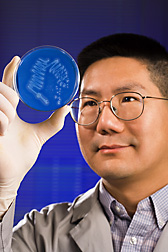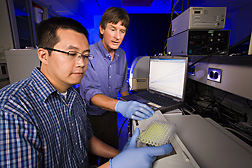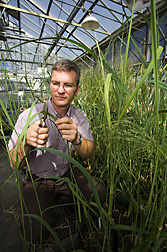Superenzymes
Turning Tough Cell Walls Into Readily Fermented Sugars
Splat!
A blob of bright-red catsup from that juicy hamburger you’re eating just landed on your favorite white shirt.
No worries. You know that a few dabs of the enzyme-powered spot remover that’s on your laundry room shelf will make every trace of the wayward condiment vanish in the wash.
If only it were that easy to find equally strong, fast-acting enzymes for biofuel chores. What’s needed are “superenzymes” that would make quick work of disassembling the tight matrix of compounds—cellulose, hemicellulose, and lignin—in cell walls of plants such as switchgrass. Right now, these recalcitrant compounds push up the cost and complexity of making cellulosic ethanol and coproducts.
That’s why researchers at the ARS Western Regional Research Center in Albany, California, are in hot pursuit of stable, highly active enzymes for biorefineries.
Enzyme Explorers
The search for excellent enzymes has taken chemist Charles Lee, and co-workers with the Albany center’s Bioproduct Chemistry and Engineering Research Unit, to outdoor places where decomposers live and work. This team has, for example, probed dank soil beneath 25-foot-high piles of decaying rice straw. And they’ve carefully drawn samples of the murky liquid in dairy-waste lagoons.
|
|
Back at the lab, these and other environmental samples—a miscellany of anonymous microbes—surrender their genetic material for what’s known as a “metagenomic analysis.” (See box below.)
Metagenomics compresses the amount of time it would otherwise take to find genes that contain the blueprints for elusive enzymes. Lee and colleagues have, for instance, used metagenomics to find a xylanase gene from a microbe living in a dairy lagoon. As its name indicates, xylanase degrades xylan, the backbone of hemicellulose.
“Xylanase genes aren’t new,” says Lee. But this one, xyn8, interests scientists because the enzyme it codes for can perform well at temperatures considered cold in the world of biofuel production. Bioenergy-related enzymes that thrive at cool temperatures are prized because they don’t need costly heating.
The scientists documented their discovery in a 2007 article in the journal Extremophiles.
A bag of compost starter mix from a nursery turned out to harbor an enzyme adept at dismantling one of the many different chemicals that branch out from hemicellulose’s xylan backbone. The new enzyme is nicknamed “AF” or “AFase,” short for alpha-L-arabinofuranosidase. “It’s one of the key enzymes needed to digest plants,” says Kurt Wagschal, a chemist at Albany.
Wagschal and coinvestigators reported the work in a 2007 issue of Enzyme and Microbial Technology.
“AFase isn’t a star performer,” says Wagschal. “But once we know more about its properties, we might combine this enzyme with another that has a similar genetic sequence. From the two, we may get a better enzyme.”
PCR Also Works
Another interesting way to create a talented new enzyme is to use PCR technology, short for polymerase chain reaction. Though perhaps best known for its ability to accurately copy scarce or rare bits of DNA in a sample, PCR’s other, lesser known use is to randomly rearrange genetic material—somewhat like the evolutionary changes that occur over time in nature.
The approach, known as “directed molecular evolution,” yields improved enzymes and is a tactic the researchers have been using for about 6 years.
The quest for new enzymes to neatly excise branches from the xylan spine has been slowed somewhat by lack of assays that detect such enzymes. To remedy that, the scientists are developing rapid, reliable tests. Lee and colleagues have created an assay for pinpointing alpha-glucuronidase enzymes. These take apart one of the branches extending from the hemicellulose spine. The new assay is unique because it can process samples more quickly than any other assay developed previously for this enzyme. A scientific journal article describing the procedure is in the works.
There’s more. Chemist Dominic Wong’s focus is enzymes that would cleave the branches that link hemicellulose to lignin. “This and other enzymes with similar actions would untangle the cell-wall structure and speed up its breakdown to sugars,” says Wong.
In addition, Wong is engineering yeasts so that they will produce not just the usual fermentation enzymes—the ones that convert sugars into ethanol—but the cell-wall-digesting enzymes, as well.
“We’d have a more efficient bioconversion process if all the enzymes that are needed were in the yeasts,” says Wong.
Equipping yeasts to do both jobs may lower costs. In the struggle to make biofuels economical, potential savings from versatile yeasts would be welcome indeed.—By Marcia Wood, Agricultural Research Service Information Staff.
This research is part of Bioenergy and Energy Alternatives, an ARS national program (#307) described on the World Wide Web at www.nps.ars.usda.gov.
Charles Lee, Kurt Wagschal, and Dominic Wong are in the Bioproduct Chemistry and Engineering Research Unit, USDA-ARS Western Regional Research Center, 800 Buchanan St., Albany, CA 94710; phone (510) 559-5858 [Lee], (510) 559-6453 [Wagschal], (510) 559-5860 [Wong], fax (510) 559-5777.
Metagenomics: A Proven Shortcut to Enzyme Genes
Metagenomics may at first seem to be a long, involved route to finding genes essential for making an industrial enzyme.
Actually, it is much faster than many other approaches.
Here’s how it works. First, microorganisms are collected from the outdoors and brought into the lab. The microbes’ genes and other DNA are, for research purposes, transferred into other organisms—such as a harmless laboratory strain of Escherichia coli.
Each E. coli can take up and activate only a few of the borrowed genes. That makes close-up scrutiny of those genes much easier.
In petri-dish tests, scientists determine whether any of the borrowed genes endow any E. coli with the ability to produce an enzyme of interest. One that degrades xylan would be of interest because xylan forms the backbone of hemicellulose, a molecule that complicates production of cellulosic ethanol.
If any E. coli are now equipped with a xylan-degrading enzyme, or “xylanase,” it takes only a few more steps to find which gene holds the blueprint for making that enzyme.
Once the new xylanase gene is found and its structure determined, the gene can be copied. After that, it can be shuttled into other microbes, such as yeasts. The yeasts follow the gene’s instructions, churning out large quantities of the enzyme for further study.
If the enzyme proves to be a champion, it might be produced commercially.—By Marcia Wood, Agricultural Research Service Information Staff.
|
|
Genes Yield Clues to Better Bioenergy Crops
Switchgrass, an American prairie icon of biofuels, is giving up some of its deepest genetic secrets. That’s happening as part of a venture to discover the structure, or sequence, of some of switchgrass’s most important genetic material: marker genes.
Also known as “ESTs”—or expressed sequence tags—marker genes act as signposts. They help researchers more quickly find genes among the molecular clutter that’s a normal part of any genome, especially one as huge as that of switchgrass.
ARS plant molecular biologists Christian Tobias, at the agency’s Western Regional Research Center in Albany, California, and Gautam Sarath, at the Grain, Forage, and Bioenergy Research Unit in Lincoln, Nebraska, are coinvestigators on the switchgrass project. It’s a collaboration with the U.S. Department of Energy’s Joint Genome Institute in Walnut Creek, California. (See “Genetic Snapshots Help Brighten Switchgrass’s Future,” Agricultural Research, April 2007.)
The inquiry will speed breeding of switchgrass to make the plants better bioenergy crops. Such plants may, for example, contain more cellulose and less lignin. Lignin interferes with conversion of cellulose to ethanol.
The collaboration has already yielded the sequence of some 65,000 ESTs. All were posted to the publicly available GenBank database earlier this year.
While the switchgrass-sequencing venture nears completion, another sequencing project that will benefit biofuels research is keeping pace. It focuses on determining the sequence of all the genetic material—or genome—of a shorter, smaller grass, Brachypodium distachyon, or purple false brome.
As a relative of switchgrass and an even closer relative of wheat, this little plant does dual duty as a model for grassy bioenergy crops and for grains such as wheat, barley, and oats. What’s more, the Brachypodium genome is a mere fraction of that of switchgrass or wheat. So this genome-sequencing project is expected to hasten discovery not only of genes needed to create superior biofuels crops, but also of genes crucial to designing superb grains.
Plant molecular biologist John Vogel at Albany and plant geneticist David Garvin, with the Plant Science Research Unit in St. Paul, Minnesota, are the U.S. codirectors of the project, which is also based at the Joint Genome Institute. (See “Brachypodium—A Little-Known Grass Gains Research Fame,” Agricultural Research, September 2008.)
A rough draft of the Brachypodium genome was posted to the publicly available www.brachypodium.org website late last year, with the final sequence expected this year.—By Marcia Wood, Agricultural Research Service Information Staff.
"Superenzymes: Turning Tough Cell Walls Into Readily Fermented Sugars" was published in the October 2008 issue of Agricultural Research magazine.










